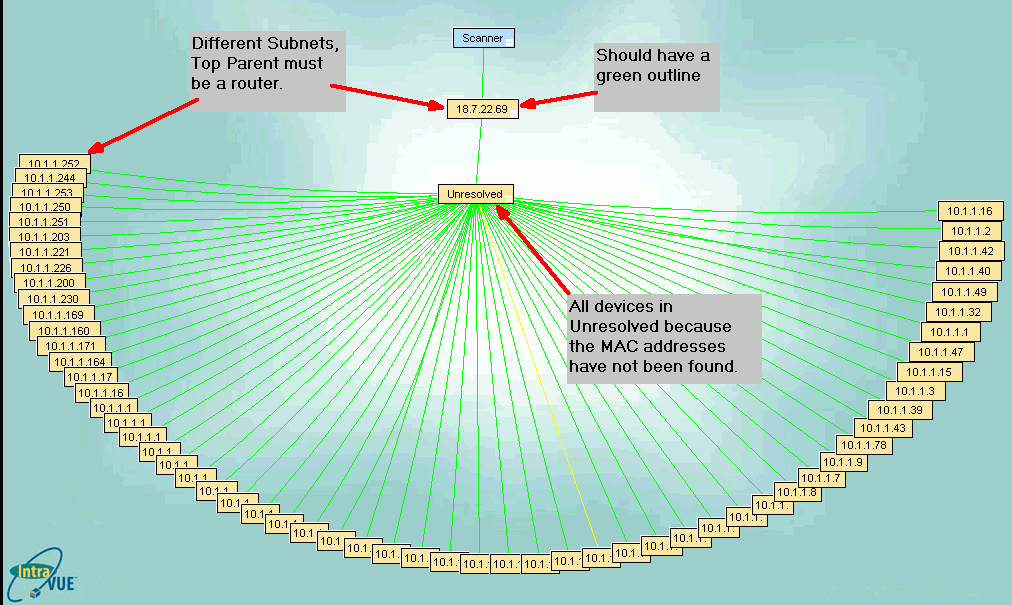
Each IntraVUE 'network' is a grouping of logical devices depending on the needs of the user. Each IntraVUE network consists of a set of scan ranges and a Top Parent.
Only two devices can be a top parent: the host computer and a router for which the snmp community is known.
The Top Parent of an IntraVUE network is the device which can provide the MAC addresses for the devices in the scan range.
Local: all devices in the same subnet as the IntraVUE host ip address.
Local is determined by applying the IP address of a computer to its subnet mask.
Pings to local ip addresses will go directly to the device and the MAC will be stored in the host computer's ARP cache.
An online subnet calculator is useful if you have unusual subnet masks.
www.subnetonline.com and
www.subnetmask.info are two examples.
Remote: all devices NOT in the same subnet as the IntraVUE host ip address. Pings and other traffic to remote devices will leave the local subnet and go to the default gateway (a router) if one is configured. The gateway will use its routing tables to direct the traffic to one of its interfaces or its gateway if it does not have an appropriate interface.
Again, the top parent of each IntraVUE network is the device which has access to the MAC address information on the devices that will be in its scan range(s).
The scanner will attempt to identify any routers that are in a scan range and the scanner will try to get additional MAC addresses from any router it finds.
If an IntraVUE network has some devices that are local and some devices that are remote, the host computer must be the top parent and one (and only one) of the router's ip addresses should be in a scan range.
If you have VLAN's each VLAN should be in a separate IntraVUE network. This will result in clearly showing the path traffic takes to go from one device to another.
If switches are in a separate VLAN, that IP address range can be added to each other VLAN's scan ranges. Thus, each IntraVUE network will have the switches and show how devices are connected. Switches that are not used in a particular VLAN can later be deleted from that IntraVUE network.
If there is one router and many VLANS and you want to scan those VLANs, make the same IP of the router the top parent of each network. Each network would then have two scan ranges - one of just one IP for the router and one for the range of devices EXCEPT the IP of the router in that range. For instance:
IntraVUE host is 10.1.1.35.
Router has IP addresses 10.1.1.1, 10.1.2.1, 10.1.3.1, and 192.168.1.254.
You want to scan all those class C ranges.
Network 1
top parent 10.1.1.35 (local host to get MACs of local devices)
range 10.1.1.0 - 10.1.1.255 (includes the router 10.1.1.1 and top parent)
Network 2
top parent 10.1.1.1
range 10.1.1.1 - 10.1.1.1 (top parent must be in a scan range)
range 10.1.2.2 - 10.1.2.255 (exclude the router's 10.1.2.1 address)
Network 3
top parent 10.1.1.1
range 10.1.1.1 - 10.1.1.1 (top parent must be in a scan range)
range 10.1.3.2 - 10.1.3.255 (exclude the router's 10.1.3.1 address)
Network 4
top parent 10.1.1.1
range 10.1.1.1 - 10.1.1.1 (top parent must be in a scan range)
range 192.168.1.1 - 192.168.1.253 (exclude the router's 192.168.1.254 address)
The purpose of the above is to avoid the scanner making unnecessary queries to the same physical router when the router is going to respond exactly the same regardless of which ip/interface you use.
IF YOU ARE SCANNING ANY DEVICES LOCAL TO THE HOST COMPUTER the host is the ONLY device which can be the top parent. This is because only the host will have the MAC addresses for the local devices which the scanner is pinging. (While the gateway router may know some of the MACs it will only know the ones that communicate outside the local subnet.

If the top parent is not the local computer, it must be a router because routers are devices that tell mac addresses when provided an IP address. In the image, the top parent is in an IP address range separate from the devices that are scanned. That is a clue that the top parent must be a router.
In the image, there is no green outline surrounding the top parent node. If the IP of the top parent IS a router, then the SNMP community is not correct or the router has been configured with an Access Control List and the IntraVUE host is not on the list.
If the top parent is not the local computer, it must have a green outline indicating there is succssful SNMP communication with the ROUTER that knows the MAC addresses of the devices in the scan range.